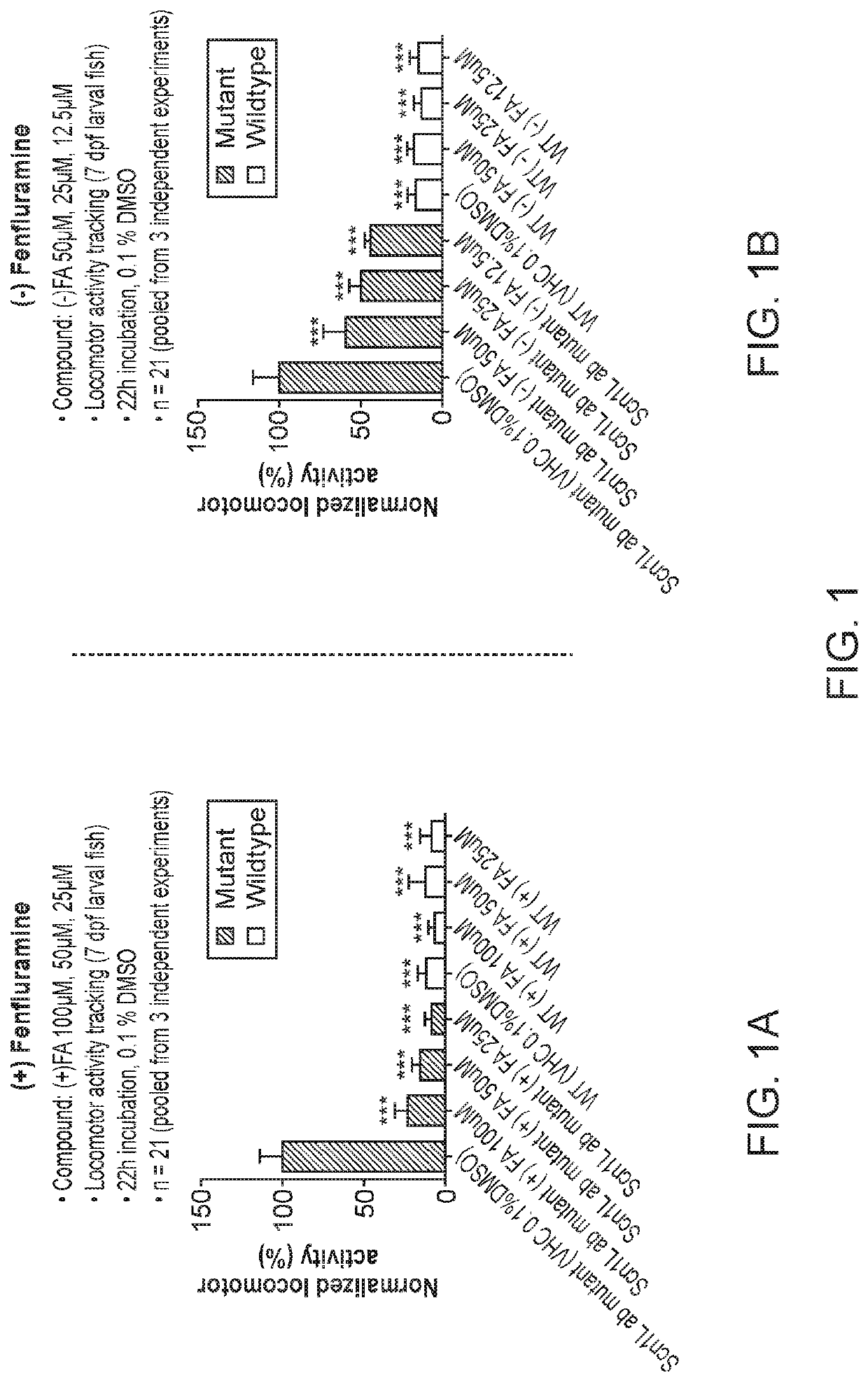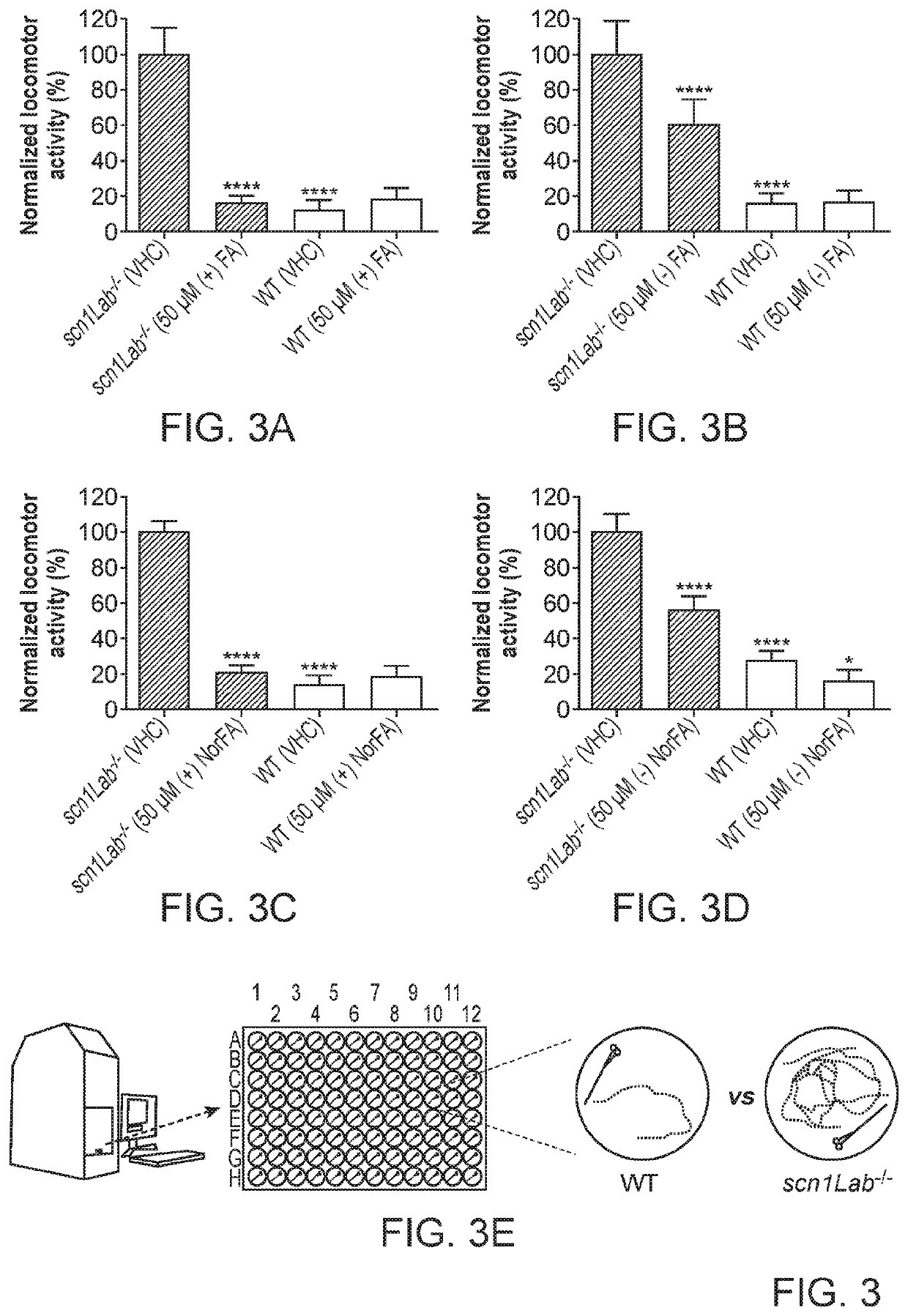Method of treating refractory epilepsy syndromes using fenfluramine enantiomers
- Summary
- Abstract
- Description
- Claims
- Application Information
AI Technical Summary
Benefits of technology
Problems solved by technology
Method used
Image
Examples
experimental examples
Example 1
Anti-Seizure Activity of Fenfluramine Enantiomers in SCN1a Mutant Zebrafish
[0138]Antiseizure activity of (−)-fenfluramine, (+)-fenfluramine, (−)-norfenfluramine and (+)-norfenfluramine in an SCN1a− / − mutant zebrafish model of Dravet syndrome were assessed and the results compared. For further detail on generation and use of the zebrafish model see, for example, Zhang Y, et al. (2015) PLoS ONE 10(5): e0125898, doi:10.1371 / journal.pone.0125898.
[0139]Zebrafish embryos (Danio rerio) heterozygous for the scn1Lab mutation (scn1Lab+ / −) are backcrossed with Tupfel longfin wildtype (WT scn1Lab+ / +) were used in measuring anti-epileptic activities substantially as reported by Sourbron, J. et al, ACS Chem. Neurosci., 2016, 7 (5), pp 588-598.
[0140]The point mutation in heterozygous or homozygous scn1Lab mutants makes it possible to distinguish them from WT scn1Lab+ / + by genotyping. In heterozygous scn1Lab+ / − mutants the PCR product contains AT3632G (wildtype allele) and AG3632G (allele ...
example 2
Anti-Seizure Effects of Dexfenfluramine in 6 Hz Mouse Models
[0152]Rapid screening of possible anticonvulsants can be performed by using acute (instead of chronic) animal models of drug-resistant seizures. One example is the acute 6-Hz model, (part of the Epilepsy Therapy Screening Program (ETSP)) which is useful as a drug screening platform for drug-resistant seizures when the intensity is set on 44 mA (Leclercq et al., 2014) and 32 mA (Wilcox et al., 2013). This idea is based on the fact that 44 mA 6-Hz seizures are resistant to several AEDs and even sodium valproate and levetiracetam are less potent at this relatively higher intensity (44 compared to 22 mA). Furthermore, this model can detect compounds with novel modes of action since it does not fully discriminate compounds based on their mechanism of action (Barton et al., 2001). In addition to the protocol using 44 mA pulses, more “lenient” versions of the model using 22 mA or 32 mA currents are sometimes employed.
[0153]Results...
example 3
[0158]Experiments were conducted to determine the dose-response effects of fenfluramine (FEN) and norfenfluramine (NOR), racemate and (+)- and (−)-isomers, in an in vivo mouse model; the dizocilpine-induced amnesia model (described below) is used to test responses to drugs acting at the sigma-1 receptor (S1R) (Maurice et al., 1994a,b; Maurice, et al., 1998, Neuroscience 83:413-428).
Materials:
[0159]Animals: Male Swiss OF-1 mice, aged 7-9 weeks and weighing 32±2 g were purchased from Janvier (St Berthevin, France). Mouse housing and experiments took place within the animal facility of the University of Montpellier (CECEMA, registration number D34-172-23). Animals were housed in groups with access to food and water ad libitum. They were kept in a temperature and humidity-controlled facility on a 12 h / 12 h light / dark cycle (lights on at 7:00 h). Behavioral experiments were carried out between 9:00 h and 17:00 h, in a sound-attenuated and air-regulated experimental room, to which mice we...
PUM
| Property | Measurement | Unit |
|---|---|---|
| Mass | aaaaa | aaaaa |
| Mass | aaaaa | aaaaa |
| Mass | aaaaa | aaaaa |
Abstract
Description
Claims
Application Information
 Login to View More
Login to View More - R&D
- Intellectual Property
- Life Sciences
- Materials
- Tech Scout
- Unparalleled Data Quality
- Higher Quality Content
- 60% Fewer Hallucinations
Browse by: Latest US Patents, China's latest patents, Technical Efficacy Thesaurus, Application Domain, Technology Topic, Popular Technical Reports.
© 2025 PatSnap. All rights reserved.Legal|Privacy policy|Modern Slavery Act Transparency Statement|Sitemap|About US| Contact US: help@patsnap.com



